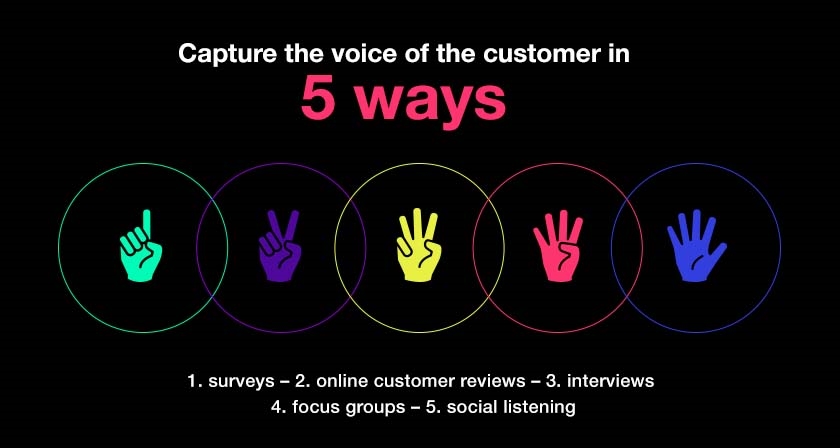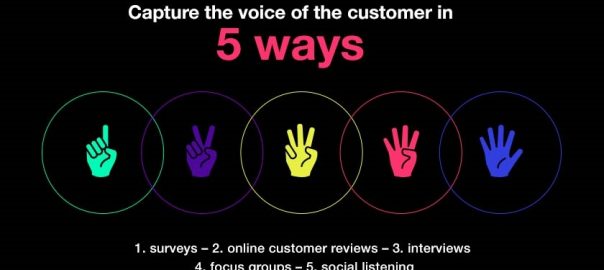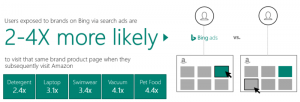The most valuable sources of VoC data for B2B marketers.
Voice of the customer data represents the opinions, desires, demands and motivations of your target customers. It allows you to understand their needs better than anyone else, helping you develop customer-driven products (and come up with effective ways to communicate with them). This ultimately enables you to differentiate your company and drive sales. But what sources should you use to capture this data? And how do you approach each source the right way?
In this article, we’ll look at five useful sources for capturing voice of the customer data and share some tips on how to get the most out of each one.
What is ‘voice of the customer’ (VoC)?
Voice of the customer (often abbreviated as VoC) is a broad term used to describe the process of capturing customer-generated data. It’s a research strategy that gives you insight into what your customers’ preferences and aversions are, which then should be used to inform your business activities.
Capturing the voice of the customer is more than just monitoring what people say to you about your brand. Companies with a strong customer orientation lean in and take proactive steps to continually gather data from a diverse range of sources – both solicited and unsolicited.
Traditionally, VoC programmes have long been recognised as a B2C affair because of the wealth of consumer data that B2C firms typically have access to. However, B2B companies shouldn’t neglect what customers say about their brand either.
Why is VoC data important for B2B companies?
VoC data is important for B2B companies for two important reasons.
Firstly, VoC data is crucial for product and feature development. Customers are an important stakeholder to your company, so it’s key that their personal opinions are taken into account. This is extremely relevant for B2B companies. After all, decision-making processes for B2B products and services are often complex and involve more than just one person, so VoC data needs to be captured to ensure adoption and minimise risk. Without it, tech and SaaS companies can easily be outrivalled by competitors. Therefore, capturing the voice of the customer helps them detect buyers’ evolving technological needs, which allows them to stay compatible with market trends.
Another reason why B2B companies should capture the voice of the customer is the fact that it improves your content marketing results. Every day, customers are bombarded with up to 10,000 marketing messages, so copy that mirrors how they actually think and talk is much more likely to convert. In fact, 52% of B2B buyers say they’re definitely more likely to purchase from a brand once they’ve read their content. This makes it even more crucial that B2B companies use VoC data to uncover key phrases their own customers use – and incorporate them throughout their content assets.
Marketers should also keep in mind that the act of gathering VoC data itself is a way of delivering value to customers. For some B2B companies, feedback only ends up with the salespeople (or worse, no one at all). With VoC, customers’ opinions have a direct pathway to your entire organisation. This can be a key differentiating factor for B2B buyers, which can help you reduce customer churn and improve satisfaction.

5 ways to capture the voice of the customer
Surveys
The vast majority of companies use surveys to gauge how well they’re performing in the eyes of their customers. As a research method, it’s a fast, inexpensive and scalable way to capture VoC. But what you actually gain from them is only as good as your approach.
With many survey tools and pre-built templates out there, it can be tempting to include questions that don’t add much value for your business – but marketers should be careful. Irrelevant or confusing questions can cause customers to provide answers that aren’t true reflections of their opinions and experiences. For example, they may not have any particular opinion about what has been asked, but they might feel pressured to provide an answer anyway. This is known as having a pseudo-attitude (a key concern in marketing research) and must be avoided at all costs, as they dilute the value of your VoC data.
Other than leaving out irrelevant questions altogether, it’s also important not to ask customers too many. Your survey might include all valuable questions, but if they take longer than a few minutes to complete, respondents will resort to satisficing – a term that describes giving the most minimal answer possible.
The best way to avoid these problems is to ensure that your survey focus remains firmly on what you need it for: finding out exactly what your customers want and expect from you. Do so, and you’ll collect high-quality VoC data worth acting on.
Online customer reviews
Like surveys, customer reviews are a cheap and effective way to capture the voice of your customers (for B2B software companies, they may be found on sites like G2, Capterra and TrustRadius).
There are two main unique benefits of using reviews as a source of VoC. Firstly, the feedback that customers write is unsolicited, which gives marketers an opportunity to obtain honest, high-quality data that may be more difficult to gather through other means. For example, your customers might love or hate certain features of your software product – this is something you may not have known otherwise. The second benefit is that reviews are usually open-ended in nature, so bias is less likely. Marketers should expect a mix of both positive and negative reviews; for VoC to truly be used effectively, it’s important to pay close attention to both.
Interviews
A more traditional source of capturing VoC data is customer interviews. They may be conducted in person, over the phone or via video conferencing software. If you already have a group of customers who use your product or service, you may ask them in detail about their reasons for purchasing and ways your company can improve.
Unlike the two aforementioned sources, one-to-one interviews grant marketers the ability to not only capture what customers say, but also how they say it with their tone of voice and body language. Also, if you choose to conduct interviews in person (for example, at their workplace), you’ll get a more holistic view of their environment and how it affects their thoughts, feelings and opinions about your product or service.
Because this is an extremely personalised form of research, you should use interviews as an opportunity to strengthen individual customer relationships.
Focus groups
For marketers, focus groups have one clear benefit: synergy.
When there are several customers in a room (physical or virtual), there is opportunity for a wide range of feedback – an extremely valuable source of data. Any comment made by any individual customer can trigger a chain reaction from others and spark lively discussions, allowing the moderator to gauge how important a particular topic is for your company.
However, there are two aspects of focus groups that marketers must get right before using this source of VoC. The moderator you choose to conduct the session must not only be knowledgeable about your industry, they should also be highly flexible and sensitive to group dynamics. Otherwise, this could lead to an unproductive session. The other key point to keep in mind is your sampling strategy. Focus group samples must be relatively homogenous; customers should share common characteristics (for example, their occupation) to ensure that everyone feels as comfortable as possible when sharing their personal perspectives. Therefore, the utmost care is needed when screening and selecting customers.
Social listening
Capturing what customers say to your company is valuable, but what’s just as necessary is capturing what they say to each other. Social media is a more informal source of collecting VoC data compared to other methods, but the information you get can be extremely useful.
B2B marketers can easily monitor conversations about their product or service on popular sites such as Twitter and LinkedIn with social media listening tools, but they shouldn’t neglect less popular platforms such as Quora and Reddit. With over 100,000 online communities on Reddit, you can draw a wealth of information about extremely niche topics that could be relevant to your business.
A key tip to using social media as a source of VoC is to not be intrusive. After all, customers may not want to actively interact with brands in places where they are not necessarily welcome – but they do want brands to listen to them.
Conclusion
The voice of the customer is an invaluable source of information for any B2B marketer. Capturing it not only informs your marketing decisions, it also facilitates an ongoing two-way conversation with your customers. Understanding how to capture VoC data using a variety of sources and approach each source effectively is critical to running a successful customer-orientated company.
Business & Finance Articles on Business 2 Community
(49)
Report Post









